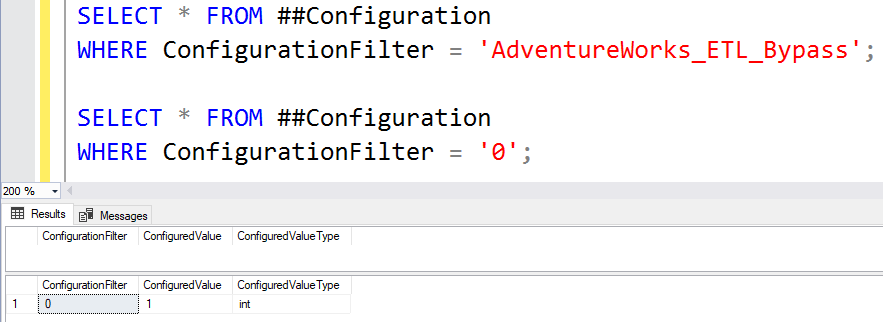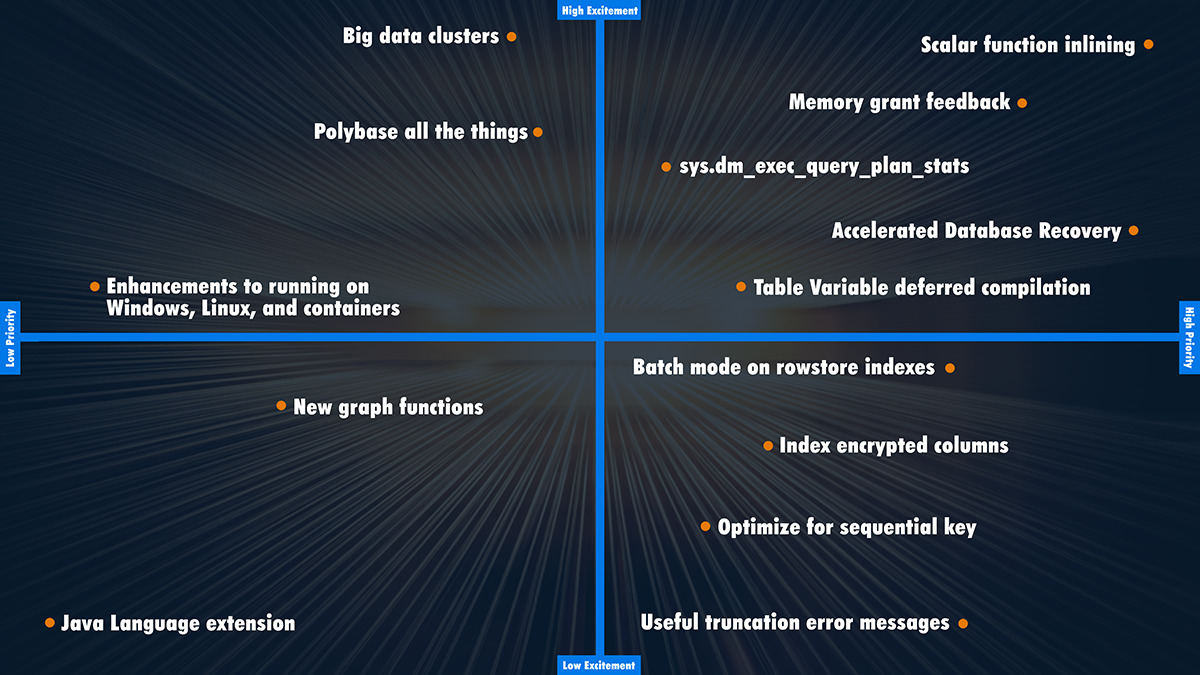Watch this week's video on YouTube
SQL Server has several ways to store queries for later executions.
This makes developers happy because it allows them to follow DRY principles: Don't Repeat Yourself. The more code you have, the more difficult it is to maintain. Centralizing frequently used code into stored procedures, functions, etc... is attractive.
While following the DRY pattern is beneficial in many programming languages, it can often cause poor performance in SQL Server.
Today's post will try to explain all of the different code organization features available in SQL Server and when to best use them (thank you to dovh49 on YouTube for recommending this week's topic and reminding me how confusing all of these different features can be when first learning to use them).
Scalar Functions
CREATE OR ALTER FUNCTION dbo.GetUserDisplayName
(
@UserId int
)
RETURNS nvarchar(40)
AS
BEGIN
DECLARE @DisplayName nvarchar(40);
SELECT @DisplayName = DisplayName FROM dbo.Users WHERE Id = @UserId
RETURN @DisplayName
END
SELECT TOP 10000 Title, dbo.GetUserDisplayName(OwnerUserId) FROM dbo.Posts
Scalar functions run statements that return a single value.
You'll often read about SQL functions being evil, and scalar functions are a big reason for this reputation. If your scalar function executes a query within it to return a single value, that means every row that calls that function runs this query. That's not good if you have to run a query once for every row in a million row table.
SQL Server 2019 can inline a lot of these, providing better performance in most cases. However, you can already do this yourself today by taking your scalar function and including it in your calling query as a subquery. The only downside is that you'll be repeating that same logic in every calling query that needs it.
Additionally, using a scalar function on the column side of a predicate will prevent SQL Server from being able to seek to data in any of its indexes; talk about performance killing.
For scalar functions that don't execute a query, you can always use WITH SCHEMABINDING to gain a performance boost.
Inline Table Valued Functions
CREATE OR ALTER FUNCTION dbo.SplitTags
(
@PostId int
)
RETURNS TABLE
AS
RETURN
(
SELECT REPLACE(t.value,'>','') AS Tags
FROM dbo.Posts p
CROSS APPLY STRING_SPLIT(p.Tags,'<') t
WHERE Id = @PostId AND t.value <> ''
)
GO
SELECT * FROM dbo.SplitTags(4)
Inline table-valued functions allow a function to return a table result set instead of just a single value. They essentially are a way for you to reuse a derived table query (you know, when you nest a child query in your main query's FROM or WHERE clause).
These are usually considered "good" SQL Server functions - their performance is decent because SQL Server can get relatively accurate estimates on the data that they will return, as long as the statistics on that underlying data are accurate. Generally this allows for efficient execution plans to be created. As a bonus, they allow parameters so if you find yourself reusing a subquery over and over again, an inline table-valued function (with or without a parameter) is actually a nice feature.
Multi-Statement Table-Valued Functions
CREATE OR ALTER FUNCTION dbo.GetQuestionWithAnswers
(
@PostId int
)
RETURNS
@results TABLE
(
PostId bigint,
Body nvarchar(max),
CreationDate datetime
)
AS
BEGIN
-- Returns the original question along with all of its answers in one result set
-- Would be better to do this with something like a union all or a secondary join.
-- But this is an MSTVF demo, so I'm doing it with multiple statements.
-- Statement 1
INSERT INTO @results (PostId,Body,CreationDate)
SELECT Id,Body,CreationDate
FROM dbo.Posts
WHERE Id = @PostId;
-- Statement 2
INSERT INTO @results (PostId,Body,CreationDate)
SELECT Id,Body,CreationDate
FROM dbo.Posts
WHERE ParentId = @PostId;
RETURN
END
SELECT * FROM dbo.GetQuestionWithAnswers(4)
Multi-statement table-valued functions at first glance look and feel just like their inline table-value function cousins: they both accept parameter inputs and return results back into a query. The major difference is that they allow multiple statements to be executed before the results are returned in a table variable:
This is a great idea in theory - who wouldn't want to encapsulate multiple operational steps into a single function to make their querying logical easier?
However, the major downside is that prior to SQL Server 2017, SQL Server knows nothing about what's happening inside of a mutli-statement table-valued function in the calling query. This means all of your estimates for MSTVFs will be 100 rows (1 if you are on a version prior to 2014, slightly more accurate if you are on versions 2017 and above). This means that execution plans generated for queries that call MSTVFs will often be...less than ideal. Because of this, MSTVFs help add to the "evil" reputation of SQL functions.
Stored Procedures
CREATE OR ALTER PROCEDURE dbo.InsertQuestionsAndAnswers
@PostId int
AS
BEGIN
SET NOCOUNT ON;
INSERT INTO dbo.Questions (Id)
SELECT Id
FROM dbo.Posts
WHERE Id = @PostId;
INSERT INTO dbo.Answers (Id, PostId)
SELECT Id, ParentId
FROM dbo.Posts
WHERE ParentId = @PostId;
END
EXEC dbo.InsertQuestionsAndAnswers @PostId = 4
Stored procedures encapsulate SQL query statements for easy execution. They return result sets, but those result sets can't be easily used within another query.
This works great when you want to define single or multi-step processes in a single object for easier calling later.
Stored procedures also have the added benefit of being able to have more flexible security rules placed on them, allowing users to access data in specific ways where they don't necessarily have access to the underlying sources.
Views
CREATE OR ALTER VIEW dbo.QuestionsWithUsers
WITH SCHEMABINDING
AS
SELECT
p.Id AS PostId,
u.Id AS UserId,
u.DisplayName
FROM
dbo.Posts p
INNER JOIN dbo.Users u
ON p.OwnerUserId = u.Id
WHERE
p.PostTypeId = 1;
GO
CREATE UNIQUE CLUSTERED INDEX CL_PostId ON dbo.QuestionsWithUsers (PostId);
SELECT * FROM dbo.QuestionsAndAnswersView;
Views are similar to inline table valued function - they allow you centralize a query in an object that can be easily called from other queries. The results of the view can be used as part of that calling query, however parameters can't be passed in to the view.
Views also have some of the security benefits of a stored procedure; they can be granted access to a view with a limited subset of data from an underlying table that those same users don't have access to.
Views also have some performance advantages since they can have indexes added to them, essentially materializing the result set in advance of the view being called (creating faster performance). If considering between an inlined table function and a view, if you don't need to parameterize the input, a view is usually the better option.
Natively Compiled Stored Procedures and Scalar Functions
CREATE TABLE dbo.QuestionsStaging (Id int PRIMARY KEY NONCLUSTERED) WITH ( MEMORY_OPTIMIZED = ON , DURABILITY = SCHEMA_ONLY );
CREATE TABLE dbo.AnswersStaging (Id int PRIMARY KEY NONCLUSTERED, PostId int) WITH ( MEMORY_OPTIMIZED = ON , DURABILITY = SCHEMA_ONLY );
GO
CREATE PROCEDURE dbo.InsertQuestionsAndAnswersCompiled
@PostId int
WITH NATIVE_COMPILATION, SCHEMABINDING
AS BEGIN ATOMIC WITH
(
TRANSACTION ISOLATION LEVEL = SNAPSHOT, LANGUAGE = N'us_english'
)
INSERT INTO dbo.Questions (Id)
SELECT Id
FROM dbo.Posts
WHERE Id = @PostId;
INSERT INTO dbo.Answers (Id, PostId)
SELECT Id, ParentId
FROM dbo.Posts
WHERE ParentId = @PostId;
END
These are same as the stored procedures and scalar functions mentioned above, except they are pre-compiled for use with in-memory tables in SQL Server.
This means instead of SQL Server interpreting the SQL query every time a procedure or scalar function has to run, it created the compiled version ahead of time reducing the startup overhead of executing one of these objects. This is a great performance benefit, however they have several limitations. If you are able to use them, you should, just be aware of what they can and can't do.
Conclusion
While writing this post I thought about when I was first learning all of these objects for storing SQL queries. Knowing the differences between all of the options available (or what those options even are!) can be confusing. I hope this post helps ease some of this confusion and helps you choose the right objects for storing your queries.






